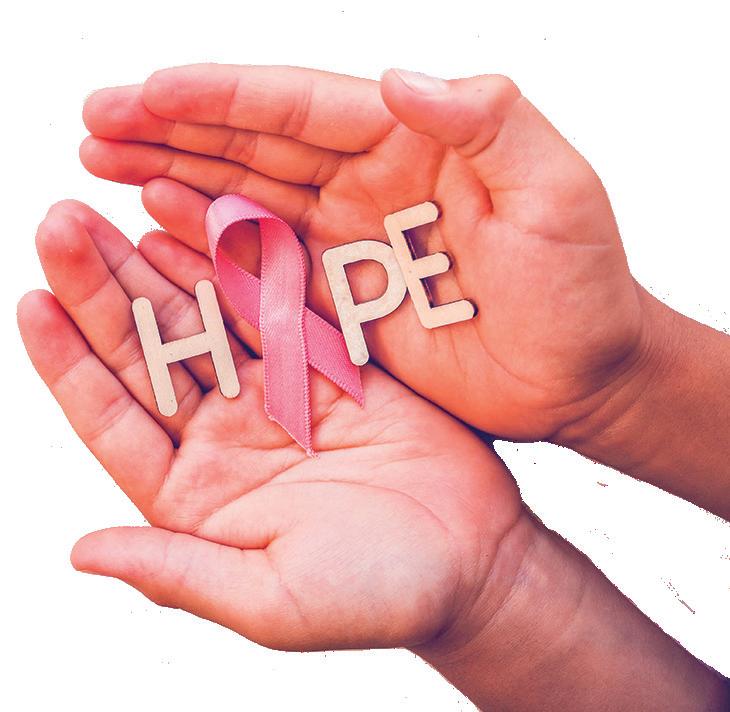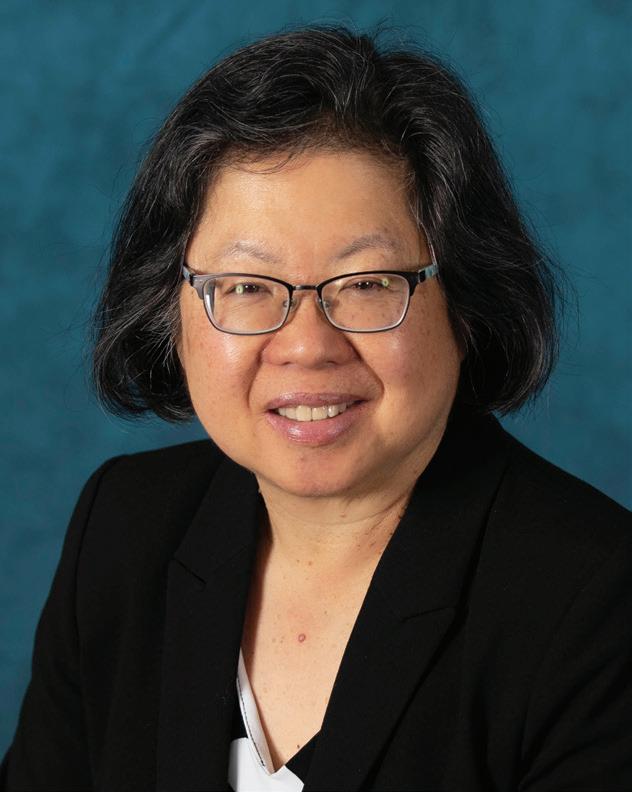15 HERALD-NEWS Herald-News/shawlocal.com/the-herald-news • Tuesday, October 10, 2023
Tracy DeGraaf is an author, speaker, humorist, stand-up comedian, entrepreneur, and mother of FIVE who inspires people to LAUGH ANYWAY and make the best of every situation, no matter what!



But it was her 2016 diagnosis and treatment for breast cancer at Silver Cross that gave Tracy a new mission: encouraging women to get their annual mammograms!
Silver Cross Hospital is pleased to host Tracy DeGraaf during Breast Cancer Awareness Month for a night of inspiration, entertainment, education and laughter!
LIFE HAPPENS, Laugh Anyway
LADIES NIGHT OUT
O ct. 19, 2023 5 -7 p.m.
Silver Cross Hospital Conference Center
Pavilion A, 1890 Silver Cross Blvd. New Lenox
There will be door prizes and the opportunity to schedule an appointment for a screening mammogram.

Seating is limited for this FREE event Register to attend at silvercross.org/classes-events or scan the QR code below
UChicago Medicine Breast Clinic at Silver Cross Hospital Offers Full Range of Surgical Options
Most women with breast cancer have some type of surgery as part of their treatment. Depending on the situation, there are different types of breast surgery, and they may be done for different reasons. For example, surgery may be done to:
• Remove as much of the cancer as possible (breast-conserving surgery or total mastectomy)
• Evaluate whether the cancer has spread to the lymph nodes under the arm (sentinel lymph node biopsy or axillary lymph node dissection)
• Restore the breast’s shape after the cancer is removed (breast reconstruction)
• Relieve symptoms of advanced cancer
As part of the cancer services partnership between University of Chicago Medicine and Silver Cross Hospital in New Lenox, Dr. Jennifer Gambla specializes in surgery for patients with breast cancer, benign breast diseases, and abnormal breast imaging.
With a dedicated, full-time practice at Silver Cross, Dr. Gambla performs a full range of procedures, including mastectomy, partial mastectomy or lumpectomy, excisional biopsies and coordinates breast reconstruction surgery with plastic surgeons at the time of breast cancer surgery. Dr. Gambla also offers a surveillance program for patients at heightened risk for breast cancer, including those with a family history.
Hidden Scar Technique
What’s more, Dr. Gambla is certified in the Hidden Scar TechniqueTM, an advanced approach to removing breast cancer in which the surgeon places the incision in a location that’s hard to see (such as in the fold under the breast or around the areola) so that the scar is not as visible when the incision heals.
As a result, patients have little or no visible reminder of the surgery or their breast cancer. And while many women see their breast surgery scars as an empowering symbol of beating cancer, many do not.
In fact, studies show that breast surgery scars can significantly impact a woman’s psychological and emotional recovery and quality of life after surgery because scars can have a large impact on a woman’s selfconfidence, intimacy and body image. The Hidden Scar approach can be performed for a nipple-sparing mastectomy or lumpectomy.
UChicago Medicine Breast Clinic at Silver Cross
Dr. Gambla, who sees patients at the UChicago Medicine Breast Clinic at Silver Cross, is certified by the American Board of Surgery. She earned her medical degree from The Ohio State University College of Medicine and completed her general residency at The Ohio State University’s Wexner Medical Center. She attended the University of Michigan for a breast surgery fellowship. Dr. Gambla also holds memberships in the American College of Surgeons and is an active participant in the American Society of Breast Surgeons. She’s been in practice since 2005 but recently came to practice in New Lenox.
Dr. Gambla’s office is located at the UChicago Medicine Breast Clinic at Silver Cross Hospital, Pavilion A, Suite 455. For more information,call 815-300-5887.
16 Herald-News/shawlocal.com/the-herald-news • Tuesday, October 10, 2023 HERALD-NEWS
Breast Surgeon Jennifer Gambla, MD, has an office at the UChicago Medicine Breast Clinic at Silver Cross Hospital in New Lenox.














17 HERALD-NEWS Herald-News/shawlocal.com/the-herald-news • Tuesday, October 10, 2023 Schedule your mammogram from here, there, or anywhere. S c re e ning mam m o grams Diagn os tic imaging D exa s c ans (CT, M RI , X- ray) Doctor/Provider Heart Scans U l traso unds L ab tes ts Urg e nt c are Schedule appointments for: With Silver Cross SCHedule NOW, you can easily schedule appointments online from anywhere! Scan the QR code or visit silvercross.org/schedule
Silver Cross Breast Health Nurse Helps Patients Navigate Breast Care
You just learned your annual mammogram results showed something concerning and have been told a biopsy – and more – is in your future.
Chances are, your mind went blank when you heard “biopsy.” And faced with what the future may hold, your mind begins going in myriad directions. But, you’re not alone if you’re in the Center for Women’s Health and Breast Center at Silver Cross Hospital in New Lenox. Byanca Ortega, RN, won’t let that happen.
For nearly two years, Ortega has helped women through one of the most stressful times of their lives.
“Most of the time, they are very, very nervous,” said Ortega, the Breast
Health Nurse Navigator at Silver Cross. “I try to be very calm as I explain what’s coming next and help them schedule follow-up procedures.
“It also helps to listen, to hear what else is going on in their lives and how all this is affecting them. They just need someone to talk to.”
Since joining Silver Cross, Ortega has helped hundreds of patients navigate high-risk or cancer diagnoses and treatment procedures, all while making sure patients know they are in good hands.
“I’ll be with them in the procedure room when they are having their biopsies, and afterward when they receive their results, letting them know the next steps all the way. It helps for them to see I’m with them through the
procedures.”
Ortega said she has worked with breast cancer patients as young as 28 and as old as the late-80s. But most are in the 50-60s range. And for her, every patient’s case is personal.
“When I come into the exam room, I try to think of what I would be feeling if this were me or a family member. I try to provide some clarity, and help them be more comfortable about what’s happening to them.
“It’s important to take it one step at a time.”
For more information about the Center for Women’s Health at Silver Cross Hospital, visit silvercross.org, or call 815-300-6350.
Byanca Ortega, RN, has helped hundreds of patients through their breast cancer diagnoses and treatment procedures at the Center for Women’s Health at Silver Cross Hospital in New Lenox.

What to know about breast cancer recurrence
Millions of women across the globe are survivors of breast cancer. Those women serve as inspiration to millions more individuals, even as they bravely live with the threat of recurrence.
The Cleveland Clinic notes that most local recurrences of breast cancer occur within five years of a lumpectomy, which is a common breast cancer treatment during which cancer cells and a small margin of healthy breast tissue are removed. Even if recurrence is unlikely and/or beyond a woman’s control, the lingering notion that breast cancer return at any moment can be difficult to confront. Learning about recurrence could calm the nerves of breast cancer survivors and their families.

DEFINING RECURRENCE
A second diagnosis of breast cancer does not necessarily mean women are experiencing a recurrence. The Cleveland Clinic notes that breast cancer that develops in the opposite breast that was not treated and does not appear anywhere else in the body is not the same thing as recurrence. Recurrence

occurs when the cancer is detected in the same breast in which the disease was initially detected. Breastcancer.org notes that cancer found in the opposite breast is likely not a recurrence.
HOW RECURRENCE HAPPENS
Recurrence can happen when single cancer cells or groups of cancer cells are left behind after surgery. Breastcancer. org notes that tests for cancer cannot detect if single cancer cells or small groups of cells are still present after surgery, and a single cell that survives post-surgery rounds of radiation therapy and chemotherapy can multiply and ultimately become a tumor.
TYPES OF BREAST CANCER RECURRENCE
There are different types of breast cancer recurrence, including:
• Local recurrence: The Cleveland Clinic notes that a local recurrence diagnosis indicates the cancer has returned to the same breast or chest area as the original tumor.
• Regional recurrence: A regional
recurrence means the cancer has come back near the original tumor, in lymph nodes in the armpit or collarbone area.
• Distant recurrence: A distant recurrence indicates the breast cancer has spread away from the original tumor. The Cleveland Clinic notes this is often referred to as stage 4 breast cancer. This diagnosis indicates the tumor has spread to the lungs, bones, brain, or other parts of the body.
THE RISK OF RECURRENCE
Johns Hopkins Medicine notes that certain variables unique to each individual affect the risk of breast cancer recurrence. This is an important distinction, as women who have survived breast cancer but are concerned about recurrence should know that they will not necessarily experience one, even if a firstdegree relative or friend did.
The type of cancer and its stage at diagnosis can elevate risk, which also is highest during the first
few years after treatment.
The Cleveland Clinic notes that women who develop breast cancer before age 35, which is uncommon, are more likely to experience a recurrence. In addition, women diagnosed with later stage breast cancers or rare forms of the disease, including inflammatory breast cancer, are more likely, though not guaranteed, to experience a recurrence.
18 Herald-News/shawlocal.com/the-herald-news • Tuesday, October 10, 2023 HERALD-NEWS
it been since your last mammogram?
A Conversation about Breast Cancer Detection, Diagnosis & Treatment


All across the country, Breast Cancer Awareness Month strives to bring awareness and education to women regarding breast cancer risk factors, early detection, and treatment. In this interview, Dr. Suzan Cheng, board certified radiation oncologist at the Radiation Therapy Center of Morris Hospital, answers some of the most commonly asked questions about breast cancer.
Q: Why is early detection important for breast cancer?
Dr. Cheng: The statistics on breastcancer are striking; one in eight women will be diagnosed with breast cancer in her lifetime. With that knowledge, it is recommended that women begin having yearly mammograms starting at age 40, as the risk for developing breast cancer increases with age. Women become most at risk starting around age 62.
While it is less common to develop breast cancer before age 50, it is important to have yearly mammograms starting at age 40. Each year, the breast images that are obtained during a mammogram are compared to the previous year to detect any irregularities or changes. The sooner irregularities are detected, more options become available for successful treatment.
Q: How is breast cancer diagnosed?

Dr. Cheng: If a woman feels a lumpin her breast, her physician would most likely send her for a breast ultrasound. Ultrasound uses sound waves to measure and see inside the lump and provides the physician with more information. For most patients, the lump is not cancerous. But if there is any suspicion remaining, a diagnos-
tic mammogram can provide better insights.
Not all methods of diagnosis are used for every patient, and age plays a role in those decisions. Younger women tend to have more gland tissue, which makes it harder to distinguish lumps when using x-ray imaging (mammography) compared to an MRI. An MRI can distinguish what the lump is, the size, and how far it is from the skin, muscle or bone. This is crucial information that helps surgeons decide whether they are going to recommend removing the lump only or the entire breast.
Q: How is breast cancer treated?
Dr. Cheng: Once a lump is detected, it is tested through a needle biopsy and sent to a laboratory. The laboratory study is able to determine whether the lump is cancerous, and most patients have the results within a few days. The next step is meeting with a surgeon and in some cases a medical oncologist who will make a surgical recommendation. If the lymph glands also need to be removed, more aggressive treatment such as radiation and/or chemotherapy may be necessary. Each case is different. Some patients might receive chemotherapy before surgery.
Q: How does family history affect the risk for breast cancer?
Dr. Cheng: Research on the impact of genetics for developing breast cancer is a topic that has gained interest in recent years.
The genetic research found that for women who have a first-degree relative (mother, daughter or sister) with breast cancer, the risk of developing breast cancer themselves doubles.

The risk also increases if the family member was under the age of 40 when diagnosed. Patients with two first-degree relatives who have been diagnosed with breast cancer are three times as likely to develop breast cancer.
Some physicians now recommend genetic analysis through a blood test for patients who have a breast cancer diagnosis. Genetic testing can be used to detect the risk of other types of cancer such as pancreatic, stom ach, ovarian and uterine cancers. If you have a family history of cancer, genetic testing may be an excellent resource to become better informed on your risk.
There’s no question mammography helps reduce deaths by detecting breast cancer early when it’s most treatable and long before it can be felt.
Q: Who can I talk to if I have a breast cancer diagnosis?

Dr. Cheng: At Morris Hospital, we have a support team of Breast Health Navigators who work with women who have received a cancer diagnosis and are seeking treatment. The navigators are registered nurses who are a resource for any questions or concerns patients may have.

For women at average risk of breast cancer, the American College of Radiology recommends an annual mammogram beginning at age Mammography really does save lives.

Offering three-dimensional mammography (digital breast tomosynthesis) in Channahon, Diamond-Coal City, Morris and Ottawa!


Q: What can I do to recognize Breast Cancer Awareness Month?

Dr. Cheng: Make sure you are up to date on your screening mammogram. For women at average risk of breast cancer, the American College of Radiology recommends an annual mammogram beginning at age 40. Women with a higher than average risk should talk to their physician about the mammography schedule that’s best for them based on their risk. There’s no question mammography can help reduce breast cancer deaths by detecting cancer early when it’s most treatable and long before it can be felt.
Dr. Suzan Cheng is a board certified radiation oncologist at the Radiation Therapy Center of Morris Hospital. She attended medical school at Case Western Reserve University in Cleveland, Ohio, and completed a residency in radiation oncology at Cleveland Clinic Foundation and University Hospitals, Case Medical Center, Cleveland and an image-guided radiation therapy research fellowship at University of California-Davis, Sacramento, California. Located at 1600 W. U.S. Route 6 in Morris, the Radiation Therapy Center of Morris Hospital provides exceptional cancer care close to home using the latest radiation therapy technology.
Call 815-942-4105 to schedule your appointment. Self-referral without a physician’s order is accepted. morrishospital.org
Herald-News/shawlocal.com/the-herald-news • Tuesday, October 10, 2023
Ladies, how long has it been since your last mammogram?
FRUITS AND VEGETABLES associated with

reducing cancer risk 5

There’s no question mammography helps reduce deaths by detecting breast cancer early when it’s most treatable and long before it can be felt.
For women at average risk of breast cancer, the American College of Radiology recommends an annual mammogram beginning at age 40.


Mammography really does save lives.

Offering three-dimensional mammography (digital breast tomosynthesis) in Channahon, Diamond-Coal City, Morris and Ottawa!



Call 815-942-4105 to schedule your appointment. Self-referral without a physician’s order is accepted.
The prevalence of cancer is widely known. Affecting people of every ethnicity and across the socioeconomic spectrum, cancer poses a threat to people in all corners of the globe. And that threat could be more significant in the immediate future. Estimates from the International Agency for Research on Cancer indicate that the global population boom and the growth of the world’s aging population could result in more than 16 million cancer deaths each year by 2040.
The statistics surrounding global incidence rates for cancer are startling, which can give the impression that cancer is an inevitability for hundreds of millions of people across the globe. However, there’s much individuals can do to reduce their cancer risk.

According to the MD Anderson Cancer Center, a healthy diet can help reduce cancer risk. A diet that focuses on plants and emphasizes healthy choices may not eliminate the threat of cancer, but it can be an integral component of a preventive health care regimen. With that in mind, the following are five fruits and vegetables associated with reducing cancer risk, courtesy of the MDACC.
1. Berries: Berries contain antioxidants, which protect the body from cell damage that can contribute to various cancers, including skin cancer, lung cancer and breast cancer, among others. Blueberries, raspberries and strawberries make wonderful additions to anyone’s diet.
morrishospital.org
2. Cruciferous vegetables: Cruciferous vegetables include broccoli, bok choy,

cabbage, and brussel sprouts, among others. The MDACC notes that studies have indicated that special plant compounds in cruciferous vegetables may protect the body from stomach cancer and cancers of the mouth, pharynx, larynx, and esophagus.
3. Garlic: The experts at Mount Sinai note that garlic is often linked with reduced risk for heart disease, notably the prevention of atherosclerosis, which affects the arteries through the deposition of plaques of fatty acids along the arterial walls. However, antioxidant-rich garlic also helps the body fight off harmful free radicals that can contribute to cancer.

4. Spinach: The Centers or Disease Control and Prevention notes that colorectal cancer is one of the leading causes of cancer deaths in the United States. Studies have found that spinach inhibits the growth of colon polyps that can develop into colorectal cancer.
5. Tomatoes: Lycopene is an antioxidant that gives tomatoes their bright red color. According to the National Cancer Institute, though human studies have produced inconsistent results, various in vitro and animal studies have indicated that lycopene may have chemopreventive effects for cancers of the prostate, skin, breast, lung, and liver.
Eating these five fruits and vegetables is not the only way to use diet in the fight against cancer. Individuals are urged to speak with their physicians to learn about the many ways to utilize food in cancer prevention.
20 Herald-News/shawlocal.com/the-herald-news • Tuesday, October 10, 2023 HERALD-NEWS
Hawk Volkswagen Teams Up With Pink Heals For Breast Cancer Awareness Month
For seven years in a row, Hawk Volkswagen located in Joliet will team up in a partnership with Pink Heals Joliet Chapter for a Think Pink event to be held on the dealership grounds on Saturday October 14th from 11am to 3pm. This event takes place in honor of breast cancer awareness month. Pink Heals of Joliet will bring out its signature pink fire trucks and sold merchandise, while Hawk VW will raffle off tickets for professional sport events, hand out free pink ribbons in honor of breast cancer awareness and accepted donations to go to the Pink Heals Joliet Chapter non-profit in order to help those who battle with finances.
“We collect donations the entire month of October to support the mission of Pink Heals. It is a mission of hope for people in the community. Every single fundraised dollar stays right here in the community and we feel good about this”said Damian Gabrus, GM at Hawk VW.
Pink Heals supports women and their families, not causes. Although the main focus is the fight against cancer, they serve those in need, no matter the illness. Setting the example by being a true non-profit, comprised of all volunteers. The pink fire trucks and police cars can be spotted out in the community and are about love and hope. They inspire and bring caring right to the doorsteps of those in need.
If you would like to make a donation to the Pink Heals Joliet Chapter, donations are being accepted at Hawk Volkswagen located at 2861 W. Jefferson St., Joliet through the month of October.



21 HERALD-NEWS Herald-News/shawlocal.com/the-herald-news • Tuesday, October 10, 2023 VEGETABLES risk













































































22 Herald-News/shawlocal.com/the-herald-news • Tuesday, October 10, 2023 HERALD-NEWS Come see my friends at Hawk VW! w VW Accepting donations all month long. 7th Annual Think Pink Fundraising Event Saturday, October 14nd • 11am to 3pm Stop by for Food & Refreshments, Free Pink Ribbons & Bracelets for Everyone. Representatives from Pink Heals AND Pink Fire Truck on hand during event 2501 W. Jefferson Street, Joliet, IL 60432 815-741-1100 | hawkvw.com Tom Thayer Former Pro Football Player Plus Tax, Title, License & Doc Fee. Jetta Cap Cost: $22930, Tiguan Cap Cost: $28988, Taos Cap Cost: $27135 , Atlas Cross Sport Cap Cost: $36698 , Atlas Cap Cost: $36897. All Leases based on 7,500 miles / year included. Pictures are for illustration purposes only Trim level shown may have a higher MSRP than vehicle being advertised. See Dealer for details. *3.65% APR, no down payment required, available on select new Volkswagen models with approved credit as determined by Volkswagen Credit. See dealer for details. Example: For 3.56% APR, monthly payment for ever y $1,000 you finance for 60 months is $18.19. #1 Claim based on 2016 - 2021 Retails Sales. Offer ends 10/31/22. MODEL YEAR END SAVINGS ON REMAINING NEW 2023 VW MODELS • 100+ Point Dealer Inspection • CARFAX® Vehicle History Report™ • 24-Hour Roadside Assistance • 2-YEAR OR 24,000-MILE Warranty (whichever occurs first) • 3-Month SiriusXM® All-Access Trial Subscription Available on Certified Pre-Owned Models 3.99%APR *Available on select models with approved credit LEASE FOR $339 PER MONTH x 39 MOS New 2024 Volkswa ATLAS CROSS SPORT 2.0T SE LEASE FOR $199 PER MONTH x 39 MOS New 202 TAOS S FWD AVAILABLE! 4.9 % APR for 60 MONTHS LEASE FOR $449 PER MONTH x 39 MOS New 2024 Volksw ATLAS 2.0 T SE n LEASE FOR $279 PER MONTH x 39 MOS New 2023 Volkswagen TIGUAN S AVAILABLE! APR for 72 MONTHS ol s VIN: 3VVCX7B27PM370550 | MSRP: $25,275 VIN: 1V2LE2CA8RC209558 | MSRP-$40,536 VIN: 3VVRB7AX4PM092728 | MSRP: $29,721 VIN: 1V2LR2CA4RC503155 | MSRP: $41,769 Joliet 30 30 52 355 80 55 59 53 7




















































